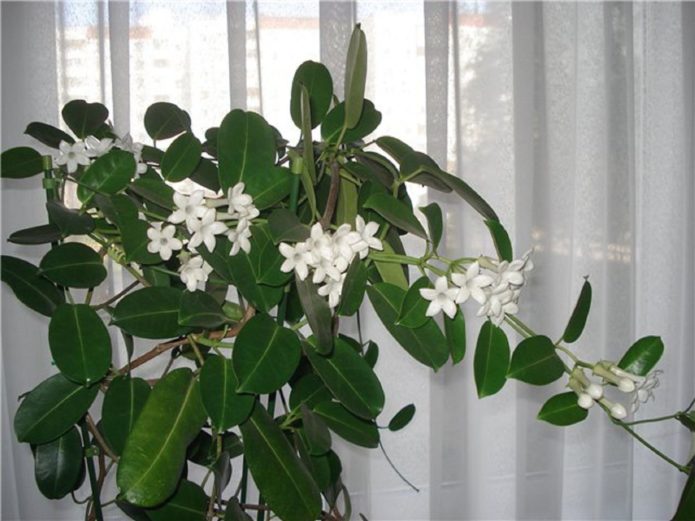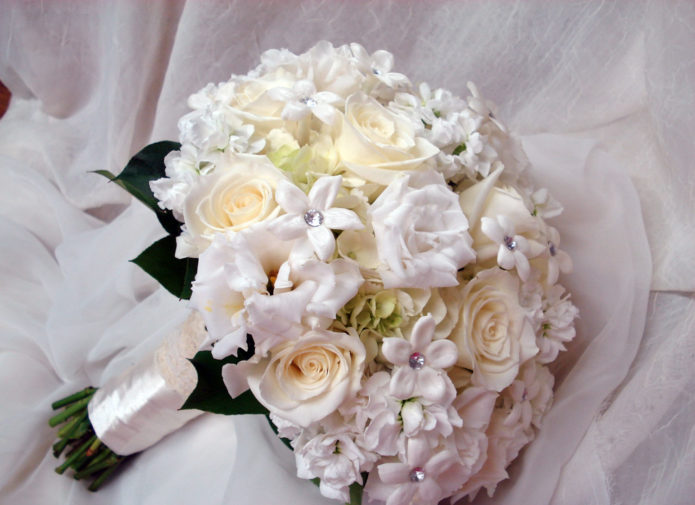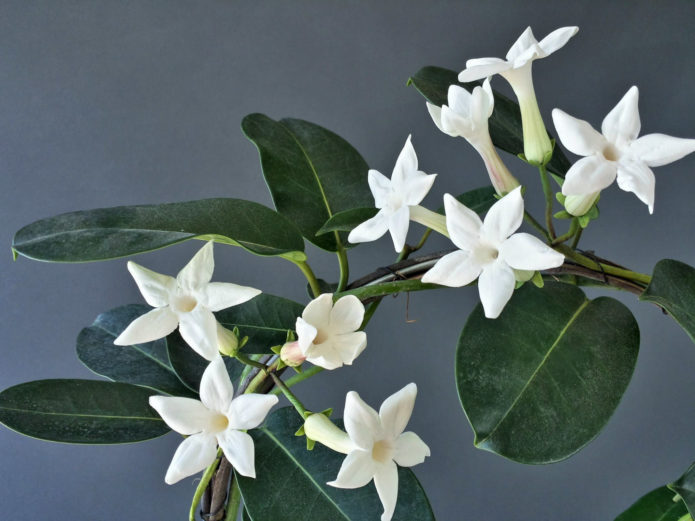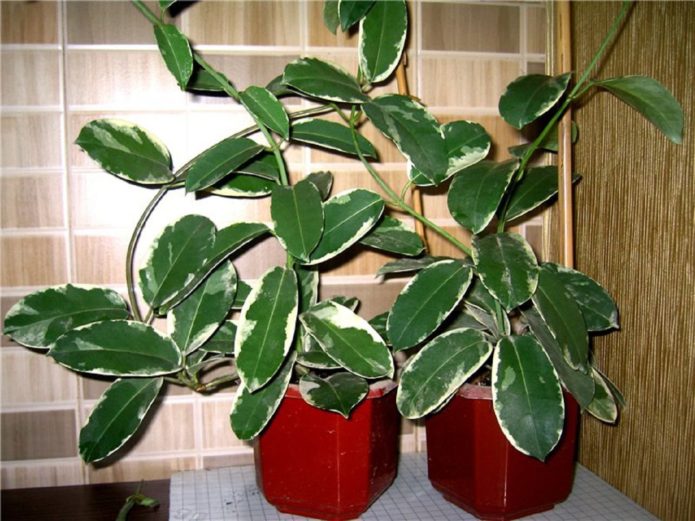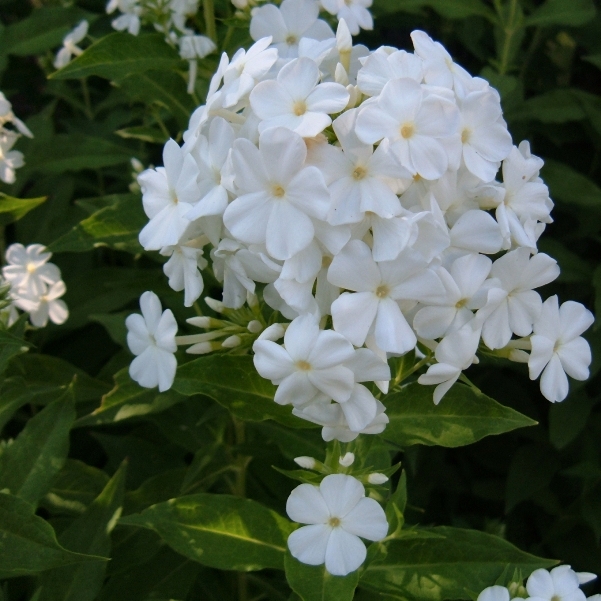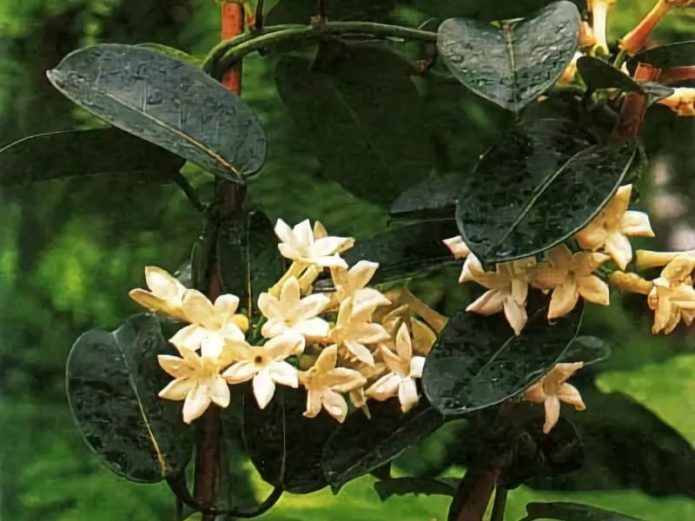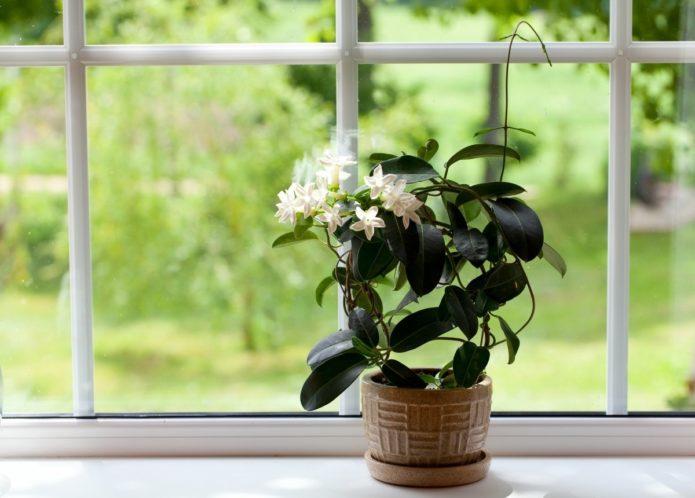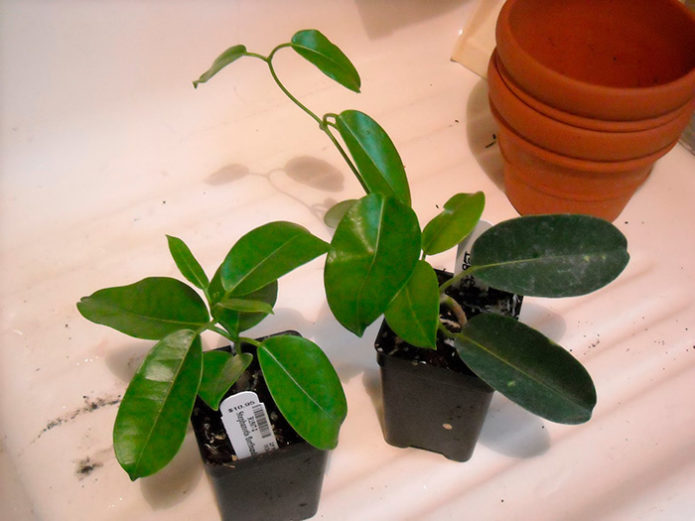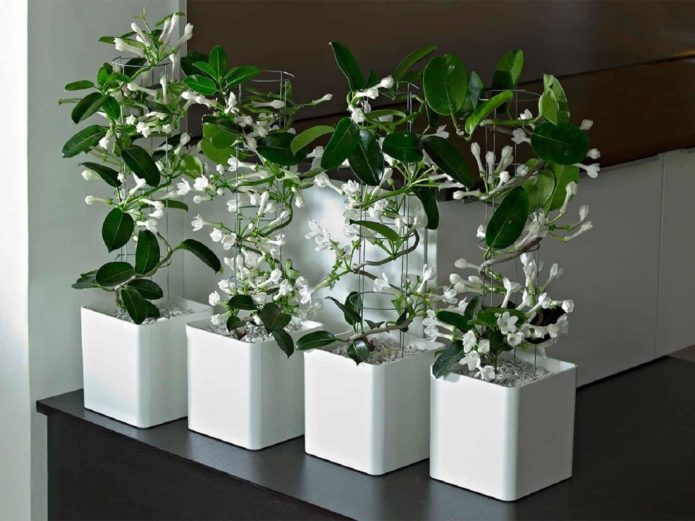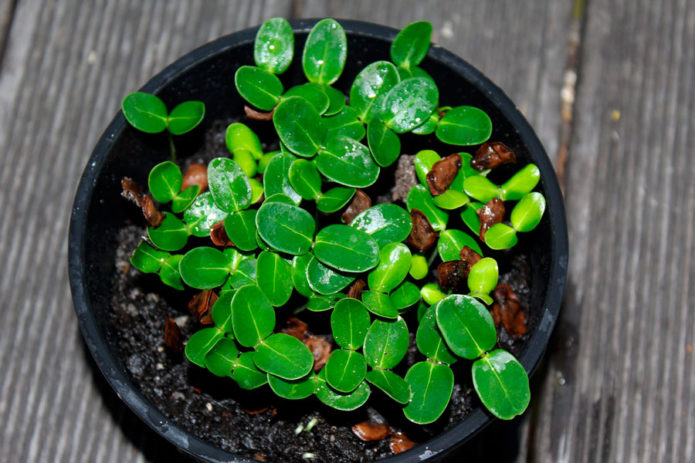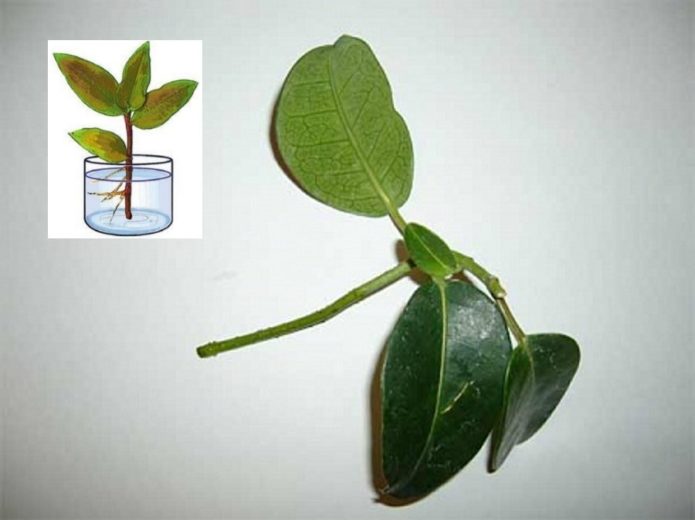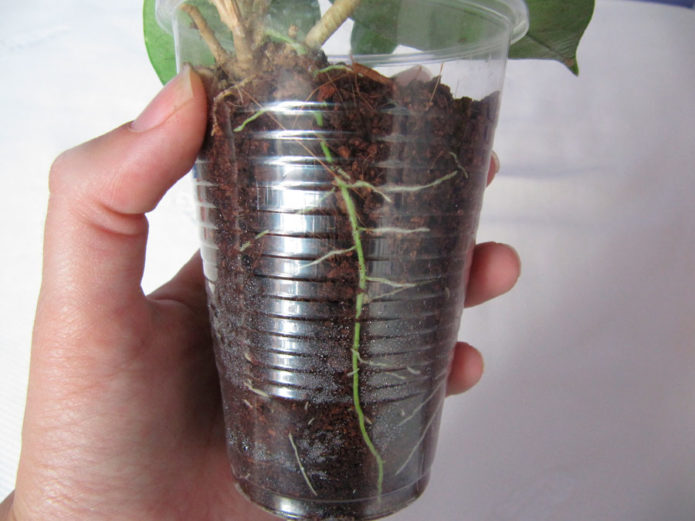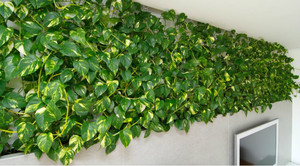Stephanotis (Latin Stephanotis) is a flowering liana-like plant belonging to the Lastovnevye family. The exotic flower is a representative of the flora of Japan, Malaysia, China and the island of Madagascar, in connection with which it is often called the Madagascar jasmine. On the territory of Russia, he has not yet become widespread, which is unfair, since he feels great in an apartment and is suitable for drawing up holiday bouquets. But do not forget that this plant is capricious and requires a special attitude towards itself.
Content
What is Stephanotis
Stephanotis is an epiphytic plant that naturally grows on large trees or shrubs, clinging to their trunks with its tenacious shoots. The stems can be up to six meters in length, so a special support is an important accessory in growing this flower.
The branches of Stephanotis are covered with oval, dark green leaves pointed at the end, which grow up to 9 cm long and up to 5 cm wide. Inflorescences are formed along the length of the entire shoot, including about seven snow-white funnel-shaped buds. Flowers grow up to 5 cm in diameter and exude a pleasant aroma. Flowering lasts from May to July, after which small-seeded pods form in place of flowers.
It is important to know that stephanotis is a poisonous plant, therefore it is necessary to exclude contact of children and pets with it.
Curious properties of a flower and associated signs
It is believed that vines pump out positive energy and are able to lead couples to divorce. But in the case of Stephanotis, everything is exactly the opposite. In European countries, the plant is a symbol of a happy family life and is often used in wedding ceremonies as a decoration or to compose a bridal bouquet. No wonder it is also called the veil vine or the flower of the bride.
Stephanotis has a special influence on women, helping them find their happiness and get married. According to the omen, the flowering of stephanotis in the house of an unmarried girl indicates an imminent marriage. The plant helps to maintain beauty and youth, and also enhances the female energy, making her mistress more attractive to men.
Another positive property of stephanotis is the ability to absorb negative energy in the house. Thanks to this, any conflict situations and disagreements are resolved peacefully.
Madagascar jasmine plays an important role in money matters. It provides financial stability and helps in building a career.
The main types and varieties with a photo
In natural conditions, there are about 16 species of Stephanotis. Only a few of them are suitable for growing at home:
- Abundantly flowering.
- Variegated.
- Grandiflora.
- Akuminata.
Profusely
This is the most common type of stephanotis, the second name of which is floribunda. It has weakly branched long stems and large white inflorescences.
Variegated
It is a variety of abundant flowering species. The main feature is light green, white or yellow spots along the edges of the leaves.
Grandiflora
The plant is distinguished by more lush inflorescences, which include up to 30 small buds. In this case, the leg of each bud is colored green.
Akuminata
A very demanding plant to care for, which can only be grown by professional flower growers. Differs from the above types with cream-colored flowers.
Care features
Stefanotis is a whimsical plant, so it is quite difficult to care for it. This is due to the need to change the conditions of detention depending on the season.
Table. Necessary conditions of detention depending on the season
| Criterion | Spring Summer | Autumn winter |
| Lighting |
|
|
| Air temperature |
|
|
| Humidity and watering |
|
|
The ideal location for the flower is the northwest window, as it needs bright sunlight until noon. The south window is also suitable for keeping it, but subject to shading in the summer. It is important to refuse to move the plant during flowering or budding in order to avoid dropping the buds.
With the arrival of October, the plant begins a dormant period that lasts until February. During this period, watering is reduced to the maximum, and the pot with the plant is rearranged in a cool and bright place.
Transplant and soil selection
After purchasing Stephanotis in a flower shop, it must be transplanted. For this, a special earthen mixture is used, which contains:
- turf - 1 part;
- peat - 1 part;
- humus - 1 part;
- river sand - 0.5 parts.
The acidity of the soil should be in the range of 5.5–6.5.
During the transplant, you must adhere to the following recommendations:
- The diameter of the new pot should be 2 cm larger than the old one, while it is better to choose earthenware or stoneware with drainage holes in the bottom.
- At the bottom of the pot, drainage material is poured, consisting of brick chips or expanded clay. This layer should occupy 1/5 of the capacity.
- The flower is transplanted by the transshipment method, that is, together with the old earthen clod.
- The free space between the walls of the pot and the rhizome is covered with a ready-made earthen mixture.
- A high-quality support is installed on top, capable of withstanding the considerable weight of the stems.
Young bushes need an annual transplant in March. Mature plants thrive in cramped conditions, while a spacious pot can be a reason to stop flowering. Therefore, replanting the bushes is enough once every 3-4 years.
Top dressing
After transplanting, Stephanotis does not need additional nutrition, since the new soil mixture contains all the necessary substances for growth and flowering. You need to fertilize the flower if it has not been transplanted for a long time. You need to start feeding from the moment the plant wakes up - in March, and continue until the end of August. In autumn and winter, it should be completely stopped.
For a rich flowering, it is worth giving preference to ready-made fertilizers with a high content of phosphorus and potassium. Nitrogenous fertilizing stimulates the growth of green mass and negatively affects budding.
Fertilizers are applied once every ten days, two hours after watering.
Bush formation
Pruning Madagascar jasmine is an important and necessary activity.This is due to the formation of buds only on young shoots. Pruning is carried out in early spring before budding begins, while old bare shoots are removed. In the summer, to ensure long flowering, they are limited to only pinching.
Young stems need to be tied up on a support, without waiting for their woodiness. The best option for this is an arch, since the plant looks luxurious on it.
Difficulties and problems during leaving
Lack of knowledge about care or failure to follow important rules can lead to many undesirable phenomena. Elimination of provoking factors usually leads to a correction of the situation.
Main problems:
- Lack of flowering.
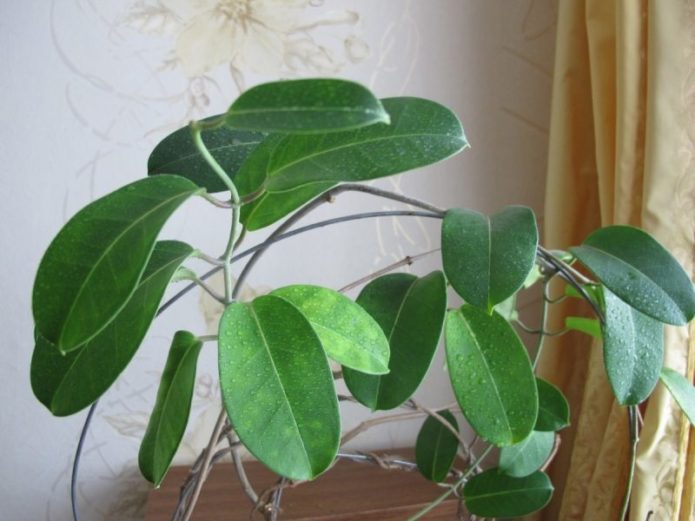 The reasons for this phenomenon lie in the errors of care. These include:
The reasons for this phenomenon lie in the errors of care. These include:- a sharp change in temperature;
- lack of a rest period;
- fertilizing with nitrogenous fertilizers;
- lack of sunlight.
- Yellowing of foliage.
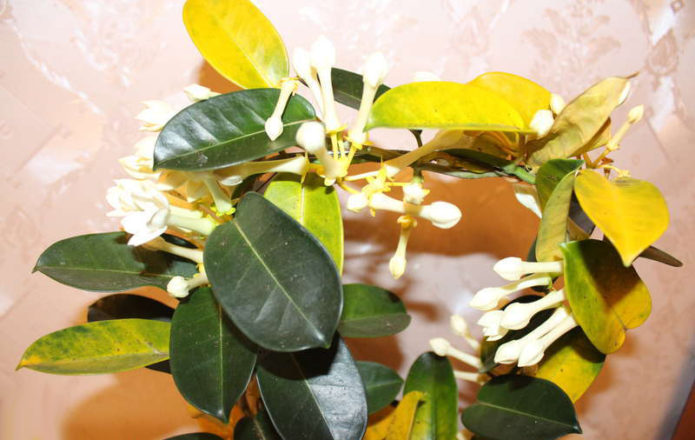 Main reasons:
Main reasons:- root injury during transplantation;
- watering with hard water;
- lack of nutrients;
- prolonged lack of lighting;
- low temperature of the content (below 13 ° C);
- stagnation of moisture in the pot.
- Falling foliage.
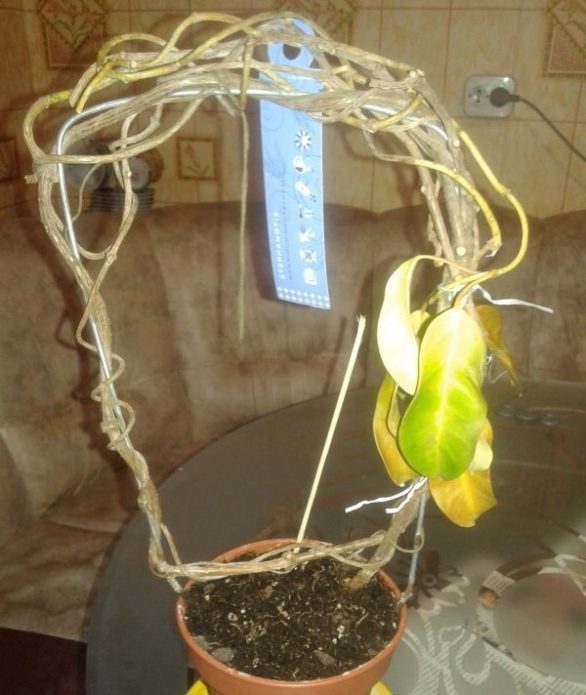 With a short daylight hours in the autumn, leaf shedding can be a plant's reaction to a lack of lighting. If this happens in the spring, then it is usually due to the influence of drafts.
With a short daylight hours in the autumn, leaf shedding can be a plant's reaction to a lack of lighting. If this happens in the spring, then it is usually due to the influence of drafts.
Deterioration in the appearance of stephanotis can occur due to infection with various pests - aphids, spider mites or scabies. To correct the situation, you need to treat the plant with an insecticide according to the instructions.
Reproduction
There are two main ways of reproduction of Stephanotis: by seeds and cuttings.
Seed propagation
With the seed method of growing, you can use both hand-picked from an adult plant, and purchased planting material.
Sowing step-by-step instructions:
- In early spring, place the seeds in warm water for two days.
- Distribute them over the surface of the soil without sprinkling it with earth, but slightly pressing into it.
- Moisten the soil with a spray bottle.
- Cover the container with transparent glass or foil.
- Place it in a bright place with an air temperature of at least 26 ° C.
It can take from 2 weeks to 2 months for seeds to germinate. During this period, it is necessary to ventilate the greenhouse every day and irrigate the soil as needed from a spray bottle. After the first leaves appear on seedlings, they are transplanted into separate containers. The grown and matured seedlings are placed in permanent pots and provide them with proper care.
Cuttings
Cuttings are the fastest and most efficient way to reproduce. This requires:
- In early spring, cut off the apical cuttings with several leaves.
- Place them in Epin or Kornevin solution for a day to stimulate root formation.
- Deepen into the prepared soil by 2 cm and cover with foil.
- Place the container with cuttings in a bright place with an air temperature of at least 25 ° C and ventilate regularly.
The roots will appear within a month. You can transplant young plants after the appearance of young shoots on them. They are seated in several pieces in a pot and transferred to a place protected from direct sunlight with an air temperature of 16-18 ° C. After the vine grows more than a meter in length, it is cut by 1/3 to enhance branching.
Stefanotis is a beautiful climbing plant, which, according to signs, favors women. But just like the representatives of the fair sex, he is capricious and requires increased attention.
